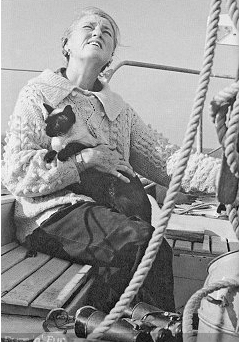Pets Aboard
From CruisersWiki
|
Going to Sea with Pets Aboard
Sailors have sailed with dogs and cats aboard for hundreds of years. For example, dogs have long been popular mascots in the United States sea services for their ability to build morale. In the early days, dogs often served a more practical function by leading patrols onto foreign shores to search for food and warn of any dangers lurking out of eyesight. But mostly, dogs provided welcome relief from the monotony of being at sea for months on end.
The ship's cat has been a common sight on many trading, exploration, and naval ships, and is a phenomenon that goes back to ancient times. Cats have been carried on ships for a number of reasons, the most important being to catch mice and rats. These rodents, when aboard, could cause considerable damage to ropes and woodwork. More serious was the threat rodents posed to the stores the ship carried. Not only could they devour the foodstuff carried to feed the crew, they could cause economic damage if the ship was carrying grain or similar substances as part of its cargo. Rats and mice were also sources of disease, an important consideration for ships which could be at sea for long periods of time. Cats naturally attack and kill these rodents.
Cats have a high ability to adapt to new surroundings, and were therefore highly suitable for service on a ship. They also offered companionship and a sense of home and security to sailors who could be away from home for long periods.
Famous ship's pets include Mrs. Chippy was the ship's cat aboard Endurance, the ship used by Sir Ernest Shackleton for his Imperial Trans-Antarctic Expedition. When the ship was lost, having become trapped and eventually crushed in pack ice, the sled dogs and Mrs. Chippy had to be put down, as they would not have survived the arduous journey ahead.
Trim was the ship's cat on a number of the ships under the command of Matthew Flinders during voyages to circumnavigate and map the coastline of Australia during 1801-03. He became a favourite of the crew and was the first cat to circumnavigate Australia. He remained with Flinders until death. A statue to Trim was later erected in his honour, and he has been the subject of a number of works of literature. A statue sits on a window sill on the outside of the Sydney Library, in Sydney, Australia.A much-traveled cruising cat was Miles and Beryl Smeeton's cat Pwe. For many years, during the 1950's-1960's she sailed aboard the Smeeton's 46-foot ketch Tzu Hang. Pwe was a blue eyed Siamese female. She is first mentioned in writing by the Smeetons in 1956 during travels in the South Pacific; she accompanied the Smeetons on many voyages, Miles once said that 'Pwe must be the saltiest cat on record.' She ultimately sailed with the Smeeton family for a total of approximately 130,000 miles. She completed a circumnavigation and many additional adventures. Pwe fell overboard without a PFD more than a thousand miles from land but was rescued by Mrs. Smeeton, an excellent swimmer. Miles Smeeton wrote several books about their adventures on Tzu Hang and life in Canada afterwards. After her full life of voyaging and retirement in the late 1960's, Pwe lived with the Smeetons in Canada for several more years before dying in 1975 at approximately 20 years of age.
Sailing with Pets Today: An Introduction
Many people don’t sail with pets because they don’t believe it is possible that their beloved pets can be comfortable aboard while underway. However, if the pet owner knows how to prepare and take care of their animal, then the family pet can happily cruise. Cruisers simply must undertake the same care to protect their pet from harm as they do in a land-based home. The extra safety precautions are similar for pets and other "non-sailors". Efforts are taken to make sure they don’t fall overboard, to have the ability to retrieve them back aboard if they do go over, preventing seasickness, hypothermia, heat exhaustion, and having appropriate first aid remedies to handle an injury while away from land.
Safety
Pet-flotation devices (PFDs) are available for cats and dogs of all sizes. Once you have purchased one that your pet will wear, give it a test run in the water to let the pet become familiar with how it feels and then walk with your pet wearing the PFD into a calm and safe body of water to make sure the PFD provides adequate support for your pet. To keep track of a pet after dark, attach a light to its harness or PFD. A red light won’t impact night vision. A flashing strobe activated by water can be attached to the PFD as well.
If you will be traveling to strange ports, get your pet an ID tag. Include your boat’s make and model, name, registration number, and a contact number. Some countries also require pets to have a microchip implanted that carries coded information about the pet, its vaccination history, and its owner. Microchip-ing the pet is a good idea even if your home country does not require it. Make sure you have a photo of your pet to show around should your pet go missing.
Life Aboard
Make sure that your vessel has adequate provisions to keep your pets comfortable: you must provide them with food, water, protection from the elements, and a safe place to rest.
Seasickness
Entering Foreign Countries With Pets
?
Before Leaving Your Home Country
Health Certificates/ vaccinations...
Procedures and Regulations
?
Your Pet's Health While Traveling
?
References
- Sailing Ships. Stevens:"Vermin", 1894. The Maritime History Virtual Archives. Retrieved Sept 8, 2012
- Dogs and the Sea Services US Naval Institute. Retrieved Sept 8, 2012
Forum Discussions
List links to discussion threads on partnering forums. (see link for requirements)
External Links
Personal Notes
Personal experiences?
|
|---|
|
Names: |
